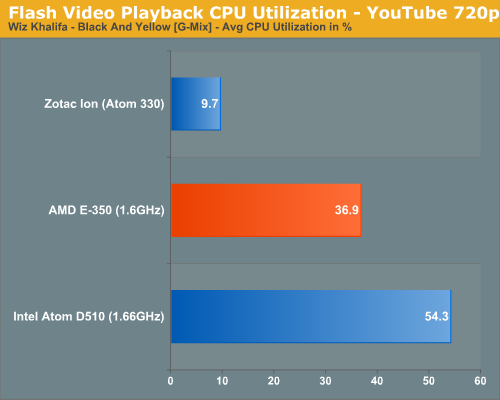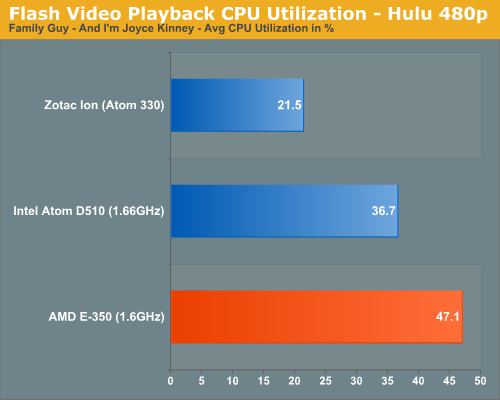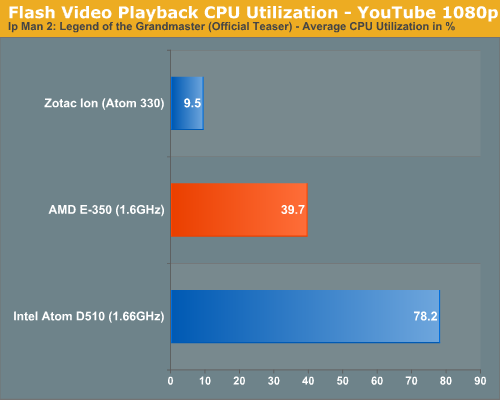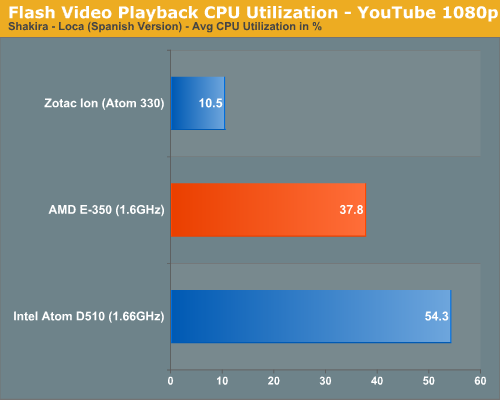The Brazos Review: AMD's E-350 Supplants ION for mini-ITX
by Anand Lal Shimpi on January 27, 2011 6:08 PM ESTBlu-ray & Flash Video Acceleration
Compatibility is obviously a strongpoint of Brazos. So long as what you’re decoding can be hardware accelerated you’re pretty much in the clear. But what about CPU utilization while playing back these hardware accelerated formats? The CPU still needs to feed data to the GPU, how many cycles are used in the process?
I fired up a few H.264/x264 tests to kick off the investigation. First we have a 1080p H.264 Blu-ray rip of Quantum of Solace, averaging around 15Mbps:
| Quantum of Solace 1080p H.264 CPU Utilization (1:00 - 1:30) | |||||
| Platform | Min | Avg | Max | ||
| AMD E-350 | 22.7% | 27.8% | 35.3% | ||
| Intel Atom D510 | Fail | ||||
| Zotac ION | 14.6% | 17.2% | 20.1% | ||
A standard Atom platform can’t decode the video but ION manages a 17% average CPU utilization with an Atom 330. Remember that the Atom 330 is a dual-core CPU with SMT (4-threads total) so you’re actually getting 17.2% of four hardware threads used, but 34.4% of two cores. The E-350 by comparison leaves 27.8% of its two cores in use during this test. Both systems have more than enough horsepower left over to do other things.
Next up is an actual Blu-ray disc (Casino Royale) but stripped of its DRM using AnyDVD HD and played back from a folder on the SSD:
| Casino Royale BD (no DRM) CPU Utilization (49:00 - 49:30) | |||||
| Platform | Min | Avg | Max | ||
| AMD E-350 | 28.1% | 33.0% | 38.4% | ||
| Intel Atom D510 | Fail | ||||
| Zotac ION | 17.7% | 22.5% | 27.5% | ||
Average CPU utilization here for the E-350 was 33% of two cores.
Finally I ran a full blown Blu-ray disc (Star Trek) bitstreaming TrueHD on the E-350 to give you an idea of what worst case scenario CPU utilization would be like on Brazos:
| Star Trek BD CPU Utilization (2:30 - 3:30) | |||||
| Platform | Min | Avg | Max | ||
| AMD E-350 | 29.0% | 40.1% | 57.1% | ||
At 40% CPU utilization on average there’s enough headroom to do something else while watching a high bitrate 1080p movie on Brazos. The GPU based video decode acceleration does work, however the limits here are clear. Brazos isn’t going to fare well as a platform you use for heavy multitasking while decoding video, even if the video decode is hardware accelerated. As a value/entry-level platform I doubt this needs much more explanation.
Now let’s talk about Flash.
I ran through a number of Flash video tests at both YouTube and Hulu ranging in resolution from 480p all the way up to 1080p. I used Flash 10.1, 10.2 beta as well as an unreleased version of 10.2 beta provided by AMD.


For the most part GPU accelerated Flash video does work well. Performance under both YouTube and Hulu was flawless, provided that I wasn’t watching 1080p content. Watching 1080p content in YouTube wasn’t entirely smooth on Brazos, despite posting very reasonable CPU utilization numbers.


I took my concerns to AMD and was told that this was a known issue with Brazos and Flash 10.1 and that 10.2 should alleviate the issue. AMD then supplied me with an unreleased version of Flash 10.2 to allow me to verify its claims. While 1080p playback improved with AMD’s 10.2 beta, it wasn’t perfect (although it was very close). AMD wouldn’t tell me the cause of the problem but it’s currently working on it with Adobe. At the end of the day I don’t believe it’s a dealbreaker, but early Brazos adapters should expect some stuttering when playing back 1080p YouTube videos. Note that 720p and lower resolution videos were perfectly smooth on Brazos.










176 Comments
View All Comments
beginner99 - Friday, January 28, 2011 - link
nope. had the exact same thought. SB also offers quicksync which could be very useful on a HTPC.Plus if you factor in total system cost especially if you use a ssd and a nice rather expensive HTPC case, the difference is not that big anymore.
Power consumption on desktop is also not a big issue unless you run it as a server 24/7.
duploxxx - Friday, January 28, 2011 - link
perhaps before you praise the quicksync that much you might want to check at which cpu it is actually supported, yes yes here is our beloved intel again cutting features for certain lower end parts :Dhttp://www.anandtech.com/show/4083/the-sandy-bridg...
sure cpu of G620 will be better then e350 but GPU won't and the E350 is fully passive and probably most will be right at the 100$ mark while there is only 1 board with that kind of price and the 70$ is bulk 1000 pieces price......
but sure you can always select the SB in a month or 2 i.s.o. the brazos, just a matter of positioning, my goal is to replace my atom netbook and that will be done very fast.
never ever will this be same power consumption.... a 35W rated cpu against a 18W get real
sebanab - Monday, January 31, 2011 - link
Llano should take care of our confused friends here.silverblue - Monday, January 31, 2011 - link
It might, but we're still talking a memory bandwidth limitation along with four tweaked Stars cores. For the moment, we don't know how the latter will affect things, but the former certainly presents an issue especially when you think about enabling AA. It'll be a big boost over Brazos, but then again, we expected that. Perhaps it'll have enough grunt to play most modern games with medium and higher details at a good frame rate, but I can't help but feel sceptical.mosu - Sunday, January 30, 2011 - link
totally wrongsilverblue - Monday, January 31, 2011 - link
Come on... a two word answer isn't an answer. :)Shadowmaster625 - Monday, January 31, 2011 - link
If intel charges $70 for budget SB 60 days after launch, I'll eat my socks. That goes against everything they stand for. $100, bare minimum.rs2 - Friday, January 28, 2011 - link
I'm wondering about the suitability of one of these systems for use as a low-volume, low power consumption web server. Obviously performance would not be stellar, but I'm wondering if it would be reasonably acceptable for a low-traffic, non-mission-critical server (for more intense loads I have a quad-core box that I can use, but the power bill associated with running it 24/7 in true server fashion makes me cringe).It seems like the E-350 is about as fast as a 3.6 GHz Pentium 4 from way back when. If so then it seems like it would make a passable server (I'm just thinking basic stuff, like Apache httpd, PHP, and MySQL...maybe Tomcat at most), no?
jjcrandall - Friday, January 28, 2011 - link
supermicro makes a atom based 1u server, so i imagine that the amd platform does a much better job than that.lordmetroid - Friday, January 28, 2011 - link
How hot are are these new processors running? Are they possible to passively cool?